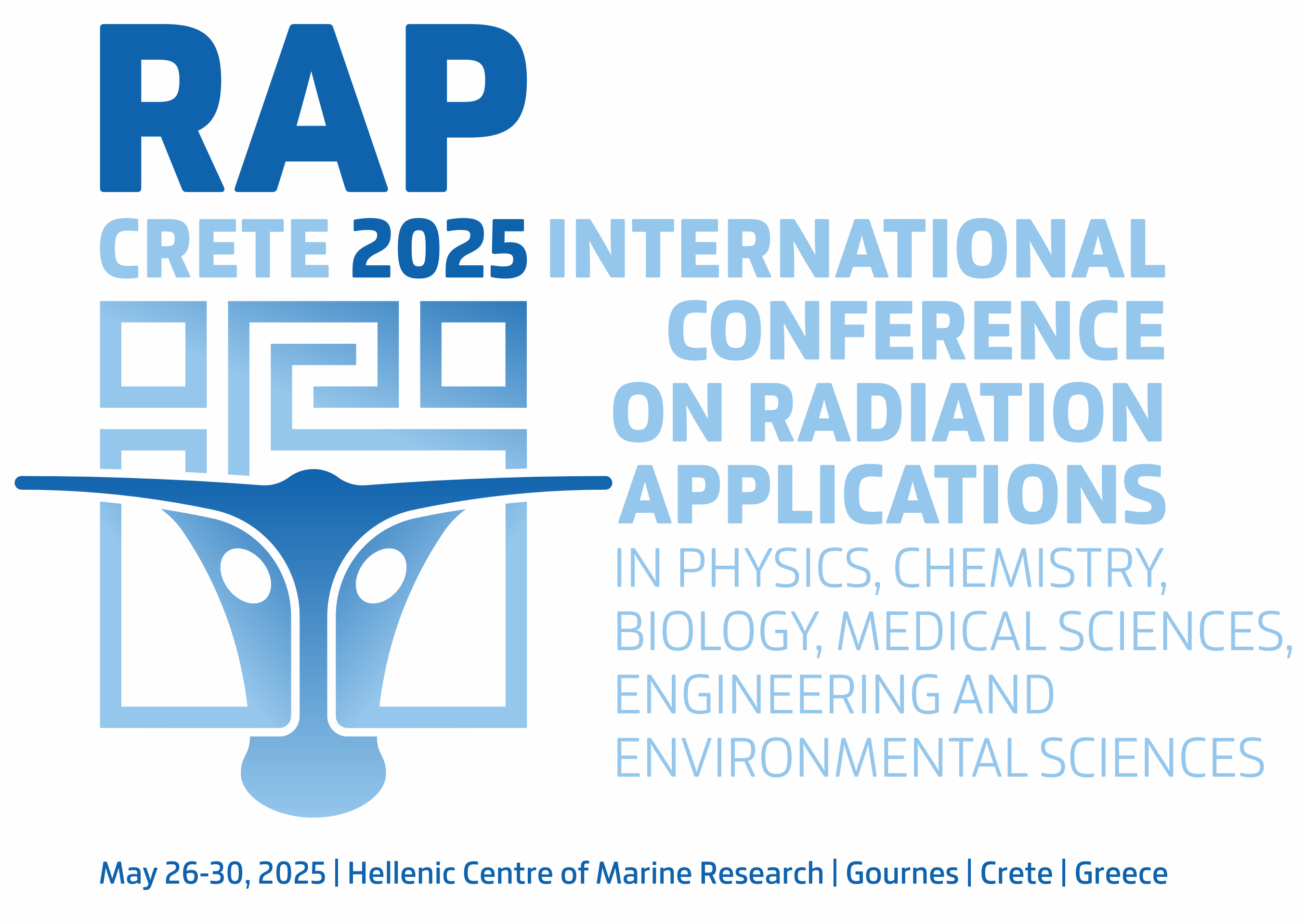Vol. 6, 2021
Radiochemistry
MODIFICATION OF 18F-FLUORODESOXY-GLUCOSE (18F-FDG) RADIOPHARMACEUTICAL BY OXIME CONJUGATION
Gergana Simeonova, Boyan Todorov, Valentina Lyubomirova
Pages: 11-15
DOI: 10.37392/RapProc.2021.03
Abstract | References | Full Text (PDF)
The isotope 18F is one of the attractive positron emitters with
commercial cyclotron production by the following nuclear reaction18O (p, n) 18F. Basically, the radionuclide 18F is used for the production of 18F-labeled
radiopharmaceuticals applied in positrone-emission tomography (PET). The
most widely used among them is 18F-fluorodeoxy-glucose (18F-FDG). 18F-FDG as glucose analog can be used to
assess the metabolism in the brain and heart, and also to study
malignancies. It plays an important role in the planning of radiation
therapy for pathologies such as lung cancer, head and neck cancer, colon
cancer. 18F-fluorodeoxy-glucose has been used in recent years as
a prosthetic group for indirect radiofluorination of biomolecules such as
peptides and proteins under relatively mild reaction conditions, which
allows the development and synthesis of more specific PET radio tracers. A
method has been developed to directly modify 18F-FDG in the
clinic environment and equipment. Simple and reliable procedure was done
with formation of an oxime chemical bond with a bifunctional compound. The
optimal reaction conditions were carried out by varying the buffer,
temperature and catalyst used. The progress of the reaction is monitored by
radio TLС - chromatography.
-
M. R. Kilbourn, Fluorine-18 labeling of radiopharmaceuticals,
Washington DC, USA: The National Academies Press, 1990.
Retrieved from: https://www.nap.edu/catalog/20467/fluorine-18-labeling-of-radiopharmaceuticals
Retrieved on: Jan. 30, 2021 -
A. O. Valdivia, J. L. López, Y. M. Vargas-Rodríguez, O. C. González,
“Producción de radiofármacos para tomografía por emisión de positrones
(PET) y su aplicación en el diagnóstico de diversas enfermedades,” Educación Química, vol. 27. núm. 4, páginas 292 – 299, Oct. 2016.
( A. O. Valdivia, J. L. López, Y. M. Vargas-Rodríguez, O. C. González,
“Production of radiopharmaceuticals for positron emission tomography (PET)
and their application in the diagnosis of various diseases,” Chem. Education, vol. 27, no. 4, pp. 292 – 299, Oct. 2016.)
Retrieved from: https://www.elsevier.es/es-revista-educacion-quimica-78-articulo-produccion-radiofarmacos-tomografia-por-emision-S0187893X16300076
Retrieved on: Jan. 30, 2021 -
Y. Chain, L. Illanes,
Radiofármacos en medicina nuclear: fundamentos y aplicación clínica
, La Plata, Argentina: EDULP, 2015.
(Y. Chain, L. Illanes,
Radiopharmaceuticals in nuclear medicine: fundamentals and clinical
application
, La Plata, Argentina: EDULP, 2015.)
Retrieved from: http://sedici.unlp.edu.ar/bitstream/handle/10915/46740/Documento_completo.pdf?sequence=1
Retrieved on: Aug. 13, 2021 -
D. L. De Guevara, “Utilidad clínica oncológica y no oncológica del PET/CT,” Rev. Med. Clin. Condes, vol. 24, núm. 1, páginas 78 – 87, Enero 2013. (D. L. De Guevara, “Clinical utility of oncological and no oncological
PET/CT,” Rev. Med. Clin. Condes, vol. 24, no. 1, pp. 78 – 87, Jan.
2013.)
Retrieved from: https://www.elsevier.es/es-revista-revista-medica-clinica-las-condes-202-articulo-utilidad-clinica-oncologica-no-oncologica-S0716864013701329?referer=coleccion
Retrieved on: Aug. 13, 2021 -
M. A. Áliva-Rodríguez, H. Alva-Sánchez, “Radiofármacos para PET, una nueva
perspectiva de la medicina nuclear molecular en México,” El Residente, vol. 5, núm. 3, páginas 103 – 110, Sep.-Dic. 2010.
(M. A. Áliva-Rodríguez, H. Alva-Sánchez, “Radiopharmaceuticals for PET, a
new perspective on molecular nuclear medicine in Mexico,”
The Resident
, vol. 5, no. 3, pp. 103 – 110, Sep.-Dec. 2010.)
Retrieved from: https://www.medigraphic.com/pdfs/residente/rr-2010/rr103c.pdf
Retrieved on: Aug. 13, 2021 -
M. Wagner, F. Wuest, “The Radiopharmaceutical Chemistry of Fluorine-18:
Electrophilic Fluorinations,” in Radiopharmaceutical Chemistry, J.
S. Lewis, A. D. Windhorst, B. M. Zeglis, Eds., 1st ed., Cham, Switzerland:
Springer, 2019, part II, pp. 285 – 295.
Retrieved from: http://library.lol/main/EDAC45121994C3798BB6B701AFD5F3F5
Retrieved on: Aug. 13, 2021 -
M. Reivich et al., “The [18F]fluorodeoxyglucose method for the measurement
of local cerebral glucose utilization in man,” Circ. Res., vol. 44, no. 1, pp. 127 – 137, Jan. 1979.
Retrieved from: https://www.ahajournals.org/doi/pdf/10.1161/01.RES.44.1.127
Retrieved on: Aug. 13, 2021 -
A. M. Rodríguez-Sánchez, “Establecimiento de controles de calidad para 18F-FDG sintetizada por hidrolisis básica y evaluación de dosis
de cristalino de POE de radiofarmacia PET con EPD, OSL y TLD,” Tesis de
maestría en ciencias, Instituto Balseiro, Física médica, San Carlos de
Bariloche, Argentina, 2016.
(A. M. Rodríguez-Sánchez, “Quality controls establishment for 18
F-FDG synthesidez by basic hydrolysis and evaluation of lens of the eyes
doses of POE of radiopharmacy PET with EPD, OSL and TLD,” M.Sc. thesis,
Balseiro Institute, Medical Physics, San Carlos de Bariloche, Argentina,
2016.)
Retrieved from: http://ricabib.cab.cnea.gov.ar/579/1/1Rodriguez_S%C3%A1nchez.pdf
Retrieved on: Jan. 30, 2021 -
K. Hamacher, H. H. Coenen, G. Stöcklin
, “Efficient stereospecific synthesis of no-carrier-added
2-[18F]-fluoro-2-deoxy-D-glucose using aminopolyether supported
nucleophilic substitution,” J. Nucl. Med., vol. 27, no. 2, pp. 235
– 238, Feb. 1986.
Retrieved from: https://jnm.snmjournals.org/content/jnumed/27/2/235.full.pdf
Retrieved on: Jan. 30, 2021 -
M. C. López, “Procedimiento de fluoración para la síntesis de 2-[ 18F]-fluoro-2-desoxi-D-glucosa,” Patente ES 2347165 T3, España,
Agosto 15, 2007.
(M. C. López, “Fluorination procedure for the synthesis of 2- [18F]
-fluoro-2-deoxy-D-glucose,” Patent ES 2347165 T3, Spain, Aug. 15, 2007.)
Retrieved from: https://patentimages.storage.googleapis.com/8a/59/46/493718a8dd6706/ES2347165T3.pdf
Retrieved on: Jan. 30, 2021 -
F. Wuest, C. Hultsch, M. Berndt, R. Bergmann, “Direct labelling of peptides
with 2-[18F]fluoro-2-deoxy-d-glucose ([18F]FDG),” Bioorg. Med. Chem. Lett., vol. 19, no. 18, pp. 5426 – 5428, Sep.
2009.
Retrieved from: https://sci-hub.se/10.1016/j.bmcl.2009.07.108
Retrieved on: Mar. 20, 2021 -
Z. Li, P. S. Conti, “Radiopharmaceutical chemistry for positron emission
tomography,” Adv. Drug Deliv. Rev., vol. 62, no. 11, pp. 1031 –
1051, Aug. 2010.
Retrieved from: https://sci-hub.se/10.1016/j.addr.2010.09.007
Retrieved on: Mar. 20, 2021 -
O. Jacobson, X. Chen, “PET designated fluoride-18 production and
chemistry,” Curr. Top. Med. Chem., vol. 10, no. 11, pp. 1048 –
1059, 2010.
Retrieved from: https://www.ncbi.nlm.nih.gov/pmc/articles/PMC3617500/pdf/nihms-454834.pdf
Retrieved on: Mar. 20, 2021 -
D. Larsen et al., “Exceptionally rapid oxime and hydrazone formation
promoted by catalytic amine buffers with low toxicity,” Chem. Sci
., vol. 9, no. 23, pp. 5252 – 5259, May 2018.
DOI: 10.1039/c8sc01082j
PMid: 29997880
PMCid: PMC6001384 -
D. K. Kölmel, E. T. Kool, “Oximes and Hydrazones in Bioconjugation:
Mechanism and Catalysis,” Chem. Rev., vol. 117, no. 15,
pp. 10358 – 10376, Aug. 2017.
Retrieved from: https://sci-hub.se/10.1021/acs.chemrev.7b00090
Retrieved on: Mar. 20, 2021 - X. G. Li, M. Haaparanta, O. Solin, “Oxime formation for fluorine-18 labeling of peptides and proteins for positron emission tomography (PET) imaging: A review,” J. Fluor. Chem., vol. 143, pp. 49 – 56, Nov. 2012.


